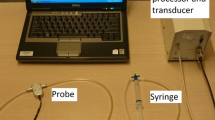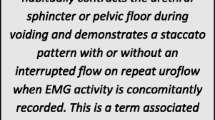Summary
A group of 72 female patients whose incontinence had persisted despite various therapies was selected for an extensive urodynamic study. Overt neuropathy was absent in the patient group. An objectified history was taken and the patients were categorized accordingly. Filling cystometry and flow studies were performed in supine and standing positions, combined with continuous measurement of urethral pressure from three points within the urethra and EMG of the urethral and anal sphincters. Urethral pressure profiles were taken at rest and under stress conditions. The history indicated stress incontinence in 23 patients, urge incontinence in 33 and mixed incontinence in 16. Cystometry and urethral profile measurement alone confirmed the history in 80% of the stress and urge patients. Urethral pressure registration during filling, however, showed that a pathologic urethral function was involved in 40 patients (14 stress, 16 urge and 10 mixed incontinents) and, as a result, changed the therapeutic approach in these cases. This pathology was not clear from the EMG recordings or the urethral pressure profiles. Continuous measurement of the urethral pressure dynamics during cystometry can unveil pathology of the urethral function as the basic cause of incontinence and thus prevent inadequate therapies from being used for these patients.
Similar content being viewed by others
References
Awad SA, McGinnis RH (1983) Factors that influence the incidence of detrusor instability in women. J Urol 130:114–115
Bates CP, Bradley WE, Glen ES, Griffiths DJ, Melchior H, Rowan D, Sterling AM, Zinner NR, Hald T (1979) The standardization of terminology of lower urinary tract function. J Urol 121:551–554
Cantor TJ, Bates CP (1980) A comparative study of symptoms and objective urodynamic findings in 214 incontinent women. Br J Obstet Gynaecol 87:889–892
Elder DD, Stephenson TP (1980) An assessment of the Frewen regime in the treatment of detrusor dysfunction in females. Br J Urol 52:467–471
Fossberg E, Beisland HO, Sander S (1981) Sensory urgency in females: treatment with Phenylpropanolamine. Eur Urol 7:157–160
Fossberg E, Beisland HO (1982) Incompetent urethral closure mechanism in females. Urol Int 37:34–41
Frewen WK (1980) The management of urgency and frequency of micturition. Br J Urol 52:367–369
Gaudenz R (1979) Der Inkontinenz-Fragebogen mit dem neuen Urge- und Stress-Score. Geburtsh Frauenheilkd 39:784–792
Jarvis GJ, Hall S, Stamp S, Millar DR, Johnson A (1980) An assessment of urodynamic examination in incontinent women. Br J Obstet Gynaecol 87:893–896
Kiruluta HG, Downie JW, Awad SA (1981) The continence mechanisms: the effect of bladder filling on the urethra. Invest Urol 18:460–465
Koefoot RB, Webster GD (1983) Urodynamic evaluation in women with frequency, urgency symptoms. Urology 21:648–651
Mahony DT, Laferte RO, Blais DJ (1980) Incontinence of urine due to instability of micturition reflexes. I. Detrusor reflex instability. Urology 15:229–239
McGuire EJ (1978) Reflex urethral instability. Br J Urol 50:200–204
McGuire EJ (1979) Urethral sphincter mechanisms. Urol Clin North Am 6:39–49
Öbrink A, Bunne G (1978) Treatment of urgency with instillation of Emepronium bromide in the urinary bladder. Scand J Urol Nephrol 12:215–218
Reed T, Andersson KE, Asmussen M, Hunting A, Ulmsten U (1980) Factors maintaining the intra-urethral pressure in women. Invest Urol 17:343–347
Tanagho EA (1979) Membrane and microtransducer catheters: their effectiveness for profilometry of the lower urinary tract. Urol Clin North Am 6:110–119
Venema PL, Kramer AEJL (1984) The clinical implication of continuous urethral pressure measurement in women with incontinence. Acta Urol Belg 52:207–215
Zinner NR, Susset JG, Coolsaet BLRA, Griffiths DJ, Jonas U, Sterling AM, Blaivas JG, Krane RJ (1983) The Great Debate. Resolved: The urethral closure pressure profile should be used for diagnosis and measurement of female stress incontinence. Neurourol Urodynam 2:81–99
Author information
Authors and Affiliations
Rights and permissions
About this article
Cite this article
Kramer, A.E.J.L., Venema, P.L. Dynamic urethral pressure measurements in the diagnosis of incontinence in women. World J Urol 2, 203–207 (1984). https://doi.org/10.1007/BF00327001
Issue Date:
DOI: https://doi.org/10.1007/BF00327001




